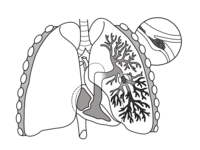
Photo from wikipedia
Objectives: Despite advances in medical therapy, reperfusion, and mechanical support, cardiogenic shock remains associated with excess morbidity and mortality. Accurate risk stratification may improve patient management. We compared the accuracy… Click to show full abstract
Objectives: Despite advances in medical therapy, reperfusion, and mechanical support, cardiogenic shock remains associated with excess morbidity and mortality. Accurate risk stratification may improve patient management. We compared the accuracy of established risk scores for cardiogenic shock. Methods: Patients admitted to tertiary care center cardiac care units in the province of Alberta in 2015 were assessed for cardiogenic shock. The Acute Physiology and Chronic Health Evaluation-II (APACHE-II), CardShock, intra-aortic balloon pump (IABP) Shock II, and sepsis-related organ failure assessment (SOFA) risk scores were compared. Receiver operating characteristic curves were used to assess discrimination of in-hospital mortality and compared using DeLong’s method. Calibration was assessed using the Hosmer-Lemeshow goodness-of-fit test. Results: The study included 3021 patients, among whom 510 (16.9%) had cardiogenic shock. Patients with cardiogenic shock had longer median hospital stays (median 11.0 vs 4.1 days, P < .001) and were more likely to die (29.0% vs 2.5%, P < .001). All risk scores were adequately calibrated for predicting hospital morality except for the APACHE-II score (Hosmer-Lemeshow P < .001). Discrimination of in-hospital mortality with the APACHE-II (area under the curve [AUC]: 0.72, 95% confidence interval [CI]: 0.66-0.76) and IABP-Shock II (AUC: 0.73, 95% CI: 0.68-0.77) scores were similar, while the CardShock (AUC: 0.76, 95% CI: 0.72-0.81) and SOFA (AUC: 0.76, 95%CI: 0.72-0.81) scores had better discrimination for predicting in-hospital mortality. Conclusions: In a real-world population of patients with cardiogenic shock, existing risk scores had modest prognostic accuracy, with no clear superior score. Further investigation is required to improve the discriminative abilities of existing models or establish novel methods.
Journal Title: Journal of Intensive Care Medicine
Year Published: 2019
Link to full text (if available)
Share on Social Media: Sign Up to like & get
recommendations!